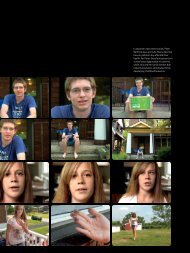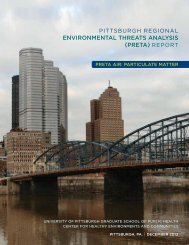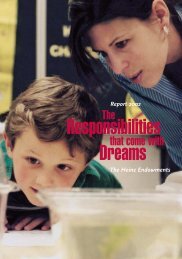View PDF - Heinz Endowments
View PDF - Heinz Endowments
View PDF - Heinz Endowments
Create successful ePaper yourself
Turn your PDF publications into a flip-book with our unique Google optimized e-Paper software.
BacxcnouND ¡,run NBBn<br />
The hidden crisis. Beneath the exterior of a thriving, fully-employed pittsburgh<br />
lies a hidden crisis. Specifically, the very factors of economic prosperity and<br />
social reform that have led increasing numbers of mothers, including low-income<br />
and single mothers, into the workforce have produced an unintended crisis of<br />
nonschool-hour care in which parents must piece together an often-changing set<br />
of care arangements and miss work to deal with gaps and glitches in that care.<br />
For example , in a 1999 nationwide survey of I , 100 adult registered voters<br />
sponsored by the Mott Foundation and J. C. Penney, nine out of ten favored<br />
providing after-school programs for children ,657o said there were not enough<br />
such programs, and 857o believed parents had difficulty finding programs in their<br />
communities. Moreover, most parents resort to forms of care that are convenient<br />
and less expensive. Research demonstrates that these arrangements are more<br />
likely to short-change their children and society in terms of poorer academic<br />
achievement and more behavior problems than would be the case if a system of<br />
structured, center-based, programmically and logistically seamless nonschoolhour<br />
care were available.<br />
't l;t' t<br />
i..ì\' ì..<br />
..lf"<br />
''(.<br />
ffÊ<br />
The children. This hidden crisis affects the<br />
majority of families of elementary school-aged<br />
children in Allegheny County. Specifically,<br />
two-thirds of elementary school-aged children<br />
- 73,000 children in the County - are estimated<br />
to need some nonschool-hour care. Only<br />
approximately l4%o of these children are<br />
enrolled in some structured center-based<br />
nonschool-hour program and only approximately<br />
277o of these programs are licensed.<br />
Therefore, the majority of children (86Vo)<br />
estimated to need nonschool-hour services<br />
more<br />
-<br />
than half of all elementary school-aged<br />
children in the County - are unaccounted for,<br />
apparently obtaining nonschool-hour care in<br />
homes or in self-care. But recent research<br />
shows that school-age children in such settings<br />
(as well as unstructured programs in centers)<br />
get less academic assistance, spend more time<br />
watching TV, and engage in unsupervised<br />
social activities. The result is they do poorer<br />
academically and have more social, emotional,<br />
and discipline problems in school than children<br />
attending structured center care during<br />
nonschool hours.<br />
¡-..r:;J.<br />
The economíc prosperìty and social reþrnts that have<br />
led íncreasing numbers of motlrcrs - ittcluding single<br />
and lotv-íttco¡ne worrten - ínto the workforce have also<br />
produced an unìntended crísis of nonscltoolJtour care,







